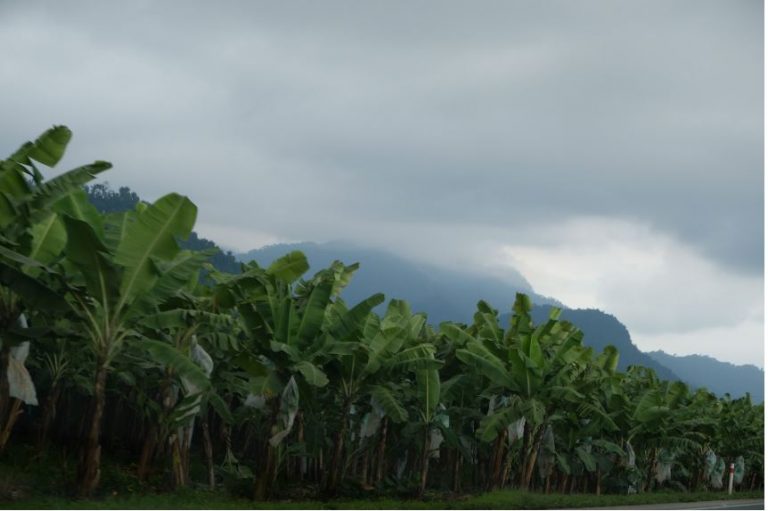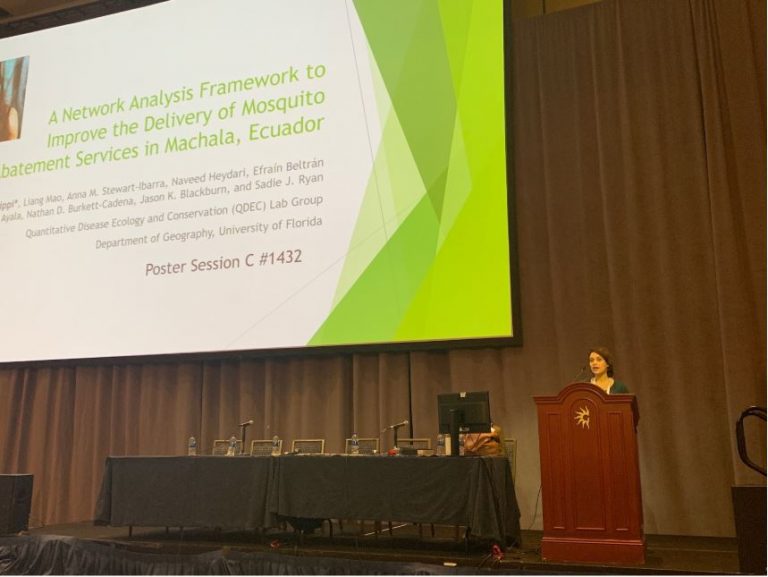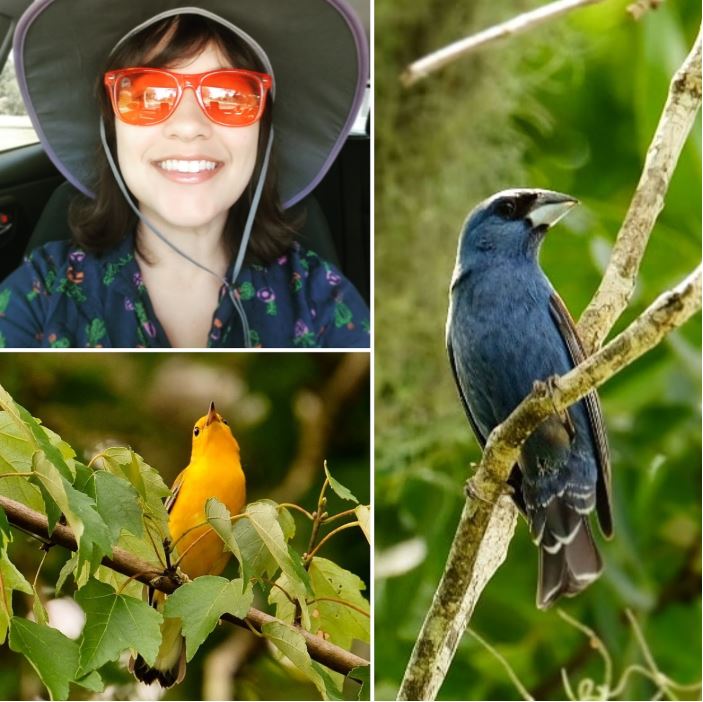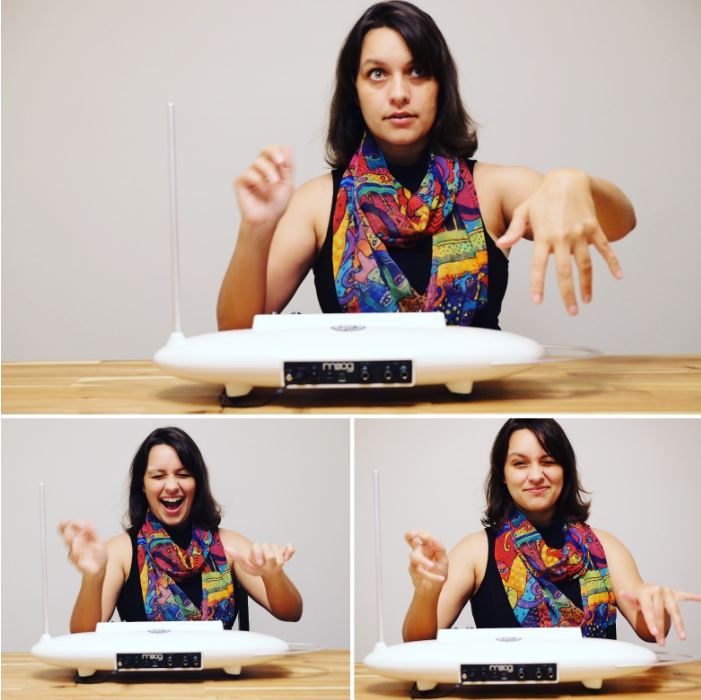
Cat Lippi
Pronouns: she/her
Quantitative Disease Ecology & Conservation Lab
Emerging Pathogens Institute
CDC Southeastern Center of Excellence in Vector Borne Diseases
Graduate Representative 2019/2020
University of Florida
Adviser: Dr. Sadie Ryan
Focus Area: Medical Geography in Global Health (MGGH)
Research Statement: I am broadly interested in vector-borne diseases, public health vector control, and investigating the social and ecological factors that affect mosquito-borne disease transmission. My graduate research is focused on arthropod-borne viruses (arboviruses) transmitted by mosquitoes in Ecuador, such as dengue, chikungunya, and Zika viruses. I conduct spatial and statistical analyses on entomological and public health surveillance data, the results of which are shared with the Ministry of Health, Ecuador to inform decision making and guide future research.

Who is she?
Cat Lippi is a fifth year PhD candidate in the Geography Department. Born in Louisiana, she has spent most of her life in Florida. She earned her B.S. in Wildlife Ecology and Conservation and M.F.A.S. in Fisheries and Aquatic Sciences at the University of Florida, before returning to UF to pursue her PhD in the Quantitative Disease Ecology & Conservation Lab (QDEC Lab) and has served as a Graduate Representative for the 2019/2020 academic year.
How did she get here?
Cat was born in Louisiana, but her family moved to Jacksonville, FL when she was 4 years old. As a child, she dreamed of becoming a wildlife veterinarian.
As a first step toward that goal, Cat pursued a B.S. in Wildlife Ecology and Conservation at the University of Florida. As an undergrad, Lippi worked in the Herpetology collection at the Florida Museum of Natural History and during the summer she worked at a small animal clinic in Jacksonville. While at the FLMNH, Cat researched the phylogeography of the eastern indigo snake in Florida – a federally protected species. Cat’s interests gradually shifted towards wildlife research. “I felt like I could make more of a difference in the world by applying research to solving conservation problems.”
After attaining her Bachelor’s degree, Cat took a job as a reptile zookeeper at St. Augustine Alligator Farm Zoological Park. After a (non-work related) accident that left her on crutches, she came to the realization that “It turns out you can’t work with gators and crocs when you’re on crutches,” and she took a job at the Jacksonville Zoo and Gardens working with marine invertebrates and stingrays (“The Stingwrangler”).
After working as a zookeeper, Cat eventually missed research, so she returned to UF to pursue a MFAS in Fisheries and Aquatic Sciences. Once she had completed her coursework for the Master’s, she nearly ran away with the circus (literally! She interviewed with Ringling Bros), but decided to take a job as a Museum Collections Assistant in the Division of Vertebrate Zoology at Yale Peabody Museum in New Haven CT, where she was able to work with both fish and herps (reptiles and amphibians). While in New Haven, she conducted her Master’s fieldwork in Long Island Sound on a National Oceanic and Atmospheric Administration (NOAA) project where she explored the role of predatory species on winter flounder, a commercially important fish species.
After completing her Master’s degree, Cat returned to St. Augustine, FL (fun fact- the oldest continuously occupied European settlement in North America) and went to work at UF’s Whitney Lab for Marine Biosciences in Marineland, FL as a lab tech in fish neurobiology and flow mechanics. After her time at Whitney Lab concluded, Cat noticed that most local science jobs required specialized statistical experience, typically centered on human health problems. Seeking to expand her quantitative skills, Cat decided to go back to school and study epidemiology and graduate level statistical analysis as she pursued a Graduate Certificate in Applied Biostatistics from the Department of Epidemiology and Biostatistics at the University of South Florida.
Once she was studying remotely at USF, she realized that specializing in public health opened a lot of doors to other jobs where she could make a positive impact in the local community. While completing her public health coursework, Cat also worked in Health Education Support at the Baker County Department of Health, as an Environmental Health Specialist at the St. Johns County Health Department, and as an Adjunct Professor of Biology at Flagler College in St. Augustine.
Cat had to fulfill a field requirement for her new public health graduate program, and most students would typically apply at a local health department. Cat, however, found a three month research opportunity as a Graduate Research Intern in Public Health Vector Control at the Anastasia Mosquito Control District in St. Augustine, allowing her to pursue a budding interest in infectious diseases. “I learned so much there in such a short amount of time!” says Cat. She was immediately hooked on mosquitoes, and the internship eventually led to an invitation to continue on a six month project. During her studies, Cat began to learn and understand the importance of arthropod-borne diseases in public health. Vector control and the study of mosquito-borne diseases was an almost perfect overlap with her ecology background and more recent training in epidemiology and public health, and she completed her graduate internship with a new focus on vector-borne infectious diseases.
When Cat earned her Graduate Certificate, she briefly considered staying on for a Master of Public Health at USF, but soon realized that working full time while completing another Master’s degree would actually take longer than just earning a PhD. After exploring different doctoral programs, Cat found a great match with Dr. Sadie Ryan at UF, and applied to join the Quantitative Disease Ecology & Conservation Lab. The research projects in QDEC were a perfect fit for Cat. She would be studying mosquito-borne disease systems in Ecuador, which was serendipitous (her husband is half Ecuadorian, and they make regular trips to visit family).

Cat’s path has been anything but linear – the things she’s done in life have been based on trying lots of things and seeing what works. Her advice, “Many students (especially undergrads) have anxiety about what they’re going to do with themselves – I would never discourage a student from working a job or getting experience to help them figure out where their place might be.”
What’s she been doing at UF?
Since joining the Department as a PhD student (and pursuing a PhD minor in Entomology), Cat has been incredibly prolific, taking courses, teaching courses, winning awards, authoring or coauthoring at least 17 papers, and serving as a Graduate Representative for the 2019/2020 academic year.

The single most influential course she’s taken was Dr. Blackburn’s Applications of GIS for Disease Ecology and Zoonosis. At the end of her fourth year as a PhD student, she regularly uses the concepts, principles, and techniques she learned in that class. The class helped make up for her lack of experience in Geography upon entering the graduate program, and helped frame her epidemiological knowledge in a geographic context. She still consults the coffee stained notes from the class on a regular basis.
As a member of the Quantitative Disease Ecology & Conservation Lab Cat’s research focuses on climate, insect populations, and arboviruses (viruses spread by arthropods, like dengue, chikungunya, and Zika virus) – frequently having an applied component. Just this year, she has published Spatiotemporal tools for emerging and endemic disease hotspots in small areas – an analysis of dengue and chikungunya in Barbados, 2013 – 2016 and A Network Analysis Framework to Improve the Delivery of Mosquito Abatement Services in Machala, Ecuador, as well as outreach articles for IFAS like Featured Creatures articles on the bromeliad mosquito, Wyeomyia vanduzeei, and the Asian bush mosquito Aedes japonicus japonicus.

All of this work has not gone unrewarded – Cat received the 2019 American Committee on Arthropod-borne Viruses (ACAV) Student Award and the 2019 Ryan Poehling Fellowship, UF Geography.

How has she been holding up during the pandemic?
In addition to working on research projects, Cat has been spending a lot of time outdoors and doing a lot birding. As part of the Alachua County Audubon Society June Challenge, Cat observed 99 different species of birds in the month of June within the county – one shy of her goal.

Just before the pandemic, Cat bought an historic home that was badly in need of renovation, which has not been going as quickly as she hoped – she’s looking forward to hosting parties, once that becomes a thing again. As if that wasn’t enough Cat has been teaching herself how to play a secondhand theremin, and has been running virtual social events for the Gainesville Roller Rebels – our local roller derby team – trying to stay connected and keep people engaged, even when they can’t skate together.

https://www.catlippi.com/
Follow Cat on Twitter
Credit: Mike Ryan Simonovich